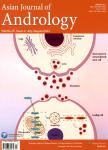Serum testosterone levels and excessive erythrocytosis during the process of adaptation to high altitudes
Serum testosterone levels and excessive erythrocytosis during the process of adaptation to high altitudes作者机构:High Altitude Research Institute and Department of Biological and Physiological Sciences Faculty of Sciences and Philosophy Universidad Peruana Cayetano Heredia Lima 31 Peru
出 版 物:《Asian Journal of Andrology》 (亚洲男性学杂志(英文版))
年 卷 期:2013年第15卷第3期
页 面:368-374页
核心收录:
学科分类:0710[理学-生物学] 071010[理学-生物化学与分子生物学] 081704[工学-应用化学] 07[理学] 0905[农学-畜牧学] 08[工学] 0817[工学-化学工程与技术] 09[农学]
基 金:supported by a grant from the Fogarty Program of The National Institutes of Health of the United States (NIH Research) funded by the Fogarty International Center, National Institutes on Environmental Health Services, National Institute for Occupational Safety and Health, and the Agency for Toxic Substances and Disease Registry
主 题:chronic mountain sickness DHEA haemoglobin high altitudes men oestradiol women
摘 要:Populations living at high altitudes (HAs), particularly in the Peruvian Andes, are characterized by a mixture of subjects with erythrocytosis (16 g dl-1〈haemoglobin (Hb)≤21 gdl-1) and others with excessive erythrocytosis (EE) (Hb〉21 g dl-1). Elevated haemoglobin values (EE) are associated with chronic mountain sickness, a condition reflecting the lack of adaptation to HA. According to current data, native men from regions of HA are not adequately adapted to live at such altitudes if they have elevated serum testosterone levels. This seems to be due to an increased conversion of dehydroepiandrosterone sulphate (DH EAS) to testosterone. Men with erythrocytosis at HAs show higher serum androstenedione levels and a lower testosterone/androstenedione ratio than men with EE, suggesting reduced 17beta-hydroxysteroid dehydrogenase (17beta-HSD) activity. Lower 17beta-HSD activity via A4-steroid production in men with erythrocytosis at HA may protect against elevated serum testosterone levels, thus preventing EE. The higher conversion of DHEAS to testosterone in subjects with EE indicates increased 17beta-HSD activity via the A5-pathway. Currently, there are various situations in which people live (human biodiversity) with low or high haemoglobin levels at HA. Antiquity could be an important adaptation component for life at HA, and testosterone seems to participate in this process.



